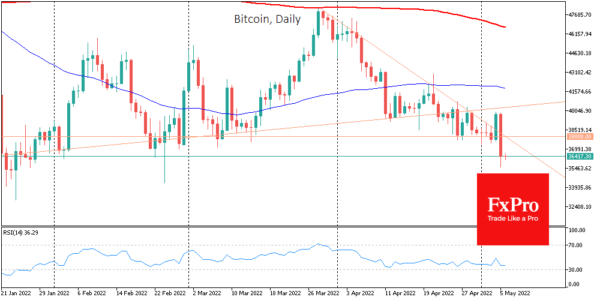Bitcoin was down more than 10% intraday on Thursday, stabilising at $36.4K from the end of the day and losing 8.3% overnight. Ethereum lost 6.7% in the last 24 hours, while other leading altcoins in the top 10 fell from 5.6% (DogeCoin) to 14% (Avalanche).
Total cryptocurrency market capitalisation, according to CoinMarketCap, fell 7.6% overnight to $1.67 trillion. The Bitcoin Dominance Index fell 0.4% to 41.5%, as the most institutionalised coins took the brunt of the hit.
The cryptocurrency Fear and Greed Index fell 5 points to 22 by Friday and moved back into “extreme fear” status. This indicator has been hovering between the 20 and 30 levels for almost four weeks.
On Thursday, Bitcoin fell sharply in the US session, losing more than $3,000 in a few hours and closing the day at its lowest level since late January. Once again, the pressure came from the US stock and bond market, where traders were furiously pricing in a sharp tightening of the Fed’s monetary policy in June after a day’s break.
The decline in BTC was the highest in the last 3.5 months and was observed simultaneously with the sell-off in the US stock market. Expectations of increasingly steep policy tightening are draining liquidity, primarily hitting risky assets, from equities to commodities to cryptocurrencies.
With yesterday’s sharp collapse, bitcoin confirmed its downtrend in late March and returned to the area of lows at the beginning of the year.
Bitcoin’s supply in the market could increase sharply in the second half of 2022 when a plan to compensate former users of the MtGox cryptocurrency exchange will begin to be implemented. However, the purchase of BTC by algorithmic stack coin issuers could potentially offset the increase in supply, according to Coinbase.
Luna Foundation Guard (LFG), a non-profit organisation, purchased 37,863 BTC on the OTC market, worth approximately $1.5 billion. LFG was one of the top 10 bitcoin holders.















